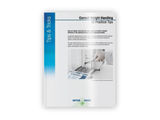To use all functions of this page, please activate cookies in your browser.
my.bionity.com
With an accout for my.bionity.com you can always see everything at a glance – and you can configure your own website and individual newsletter.
- My watch list
- My saved searches
- My saved topics
- My newsletter
Radial keratotomyRadial keratotomy (RK) is a refractive surgical procedure to correct myopia. Additional recommended knowledge
DiscoveryThe procedure was discovered by accident by Svyatoslav Fyodorov who removed glass from the eye of one of his patients who had been in an accident. A boy, who wore eyeglasses, fell off his bicycle and his glasses shattered on impact, with glass particles lodging in his eyes. A procedure was performed consisting of making numerous radial incisions which extended from the pupil to the periphery of the cornea in a pattern like the spokes of a wheel. After the glass was removed (by this method) and the cornea healed, he found that the patient's eyesight was significantly improved.[1] Procedure detail
In radial keratotomy (RK), incisions are made with a precision calibrated diamond knife. It has been found that incisions that penetrate only the superficial corneal stroma are less effective than those reaching deep into the cornea,[2] and consequently incisions are made quite deep. One study cites incisions made to a depth equivalent to the thinnest of four corneal-thickness measurements made near the centre of the cornea.[3] Other sources cite surgeries leaving 20 to 50 micrometres of corneal tissue unincised (roughly equivalent to 90% of corneal depth based on thickness norms).[2] Arcuate keratotomy is still popular to correct astigmatism. It is also done with a diamond knife but in these cases, cuts are made circumferentially, parallel to the edge of the cornea. Postsurgical healing
The healing corneal wounds are comprised of newly abutting corneal stroma as well as fibroblastic cells and irregular fibrous tissue. Closer to the wound surface lies the epithelial plug, a bed of the cells that form the normal corneal epithelium, which have fallen into the wound. Often this plug is three to four times as deep as the normal corneal epithelium layer. As the cells migrate from the depth of the plug up to the surface, some die before reaching the surface, forming breaches in the otherwise healthy epithelial layer. This consequently leaves the cornea more susceptible to infection.[4][5][6] This risk is estimated to be between 0.25%[7] and 0.7%[8] Healing of the RK incisions is very slow and unpredictable, often incomplete even years after surgery.[9] Similarly, infection of these chronic wounds can also occur years after surgery,[10][11][12] with 53% of ocular infections being 'late' in onset.[13] The pathogen most commonly involved in such infections is the highly virulent bacterium Pseudomonas aeruginosa.[14] Side effectsLarge epithelial plugs may cause more scattering of light, leading to symptoms of flare and 'starbursts'. This can happen especially in situations like night driving, where the stark glare of car headlights abounds. These dark conditions cause the pupil to dilate, maximizing the amount of scattered light that enters the eye. In cases where large epithelial plugs lead to such aggravating symptoms, patients may seek further surgical treatment to alleviate the symptoms.[4] Increasing altitude can cause partial blindness in radial keratotomy patients, as discovered by mountaineer Beck Weathers (who had had the surgery) during the 1996 Mount Everest disaster. References
Categories: Surgery | Medical treatments |
|||||||||||||||||||
| This article is licensed under the GNU Free Documentation License. It uses material from the Wikipedia article "Radial_keratotomy". A list of authors is available in Wikipedia. | |||||||||||||||||||
- Species_distribution
- Spermatocytogenesis
- Biogen Idec and Abbott Announce Positive Top-Line Results from the First Registrational Trial for Daclizumab HYP in Relapsing-Remitting Multiple Sclerosis - SELECT Study Demonstrates Significant Reductions in Annualized Relapse Rate and Meets Key Secondary Endpoints
- CyBio FeliX | Robot di pipettaggio | Analytik Jena
- Müllerian_duct







